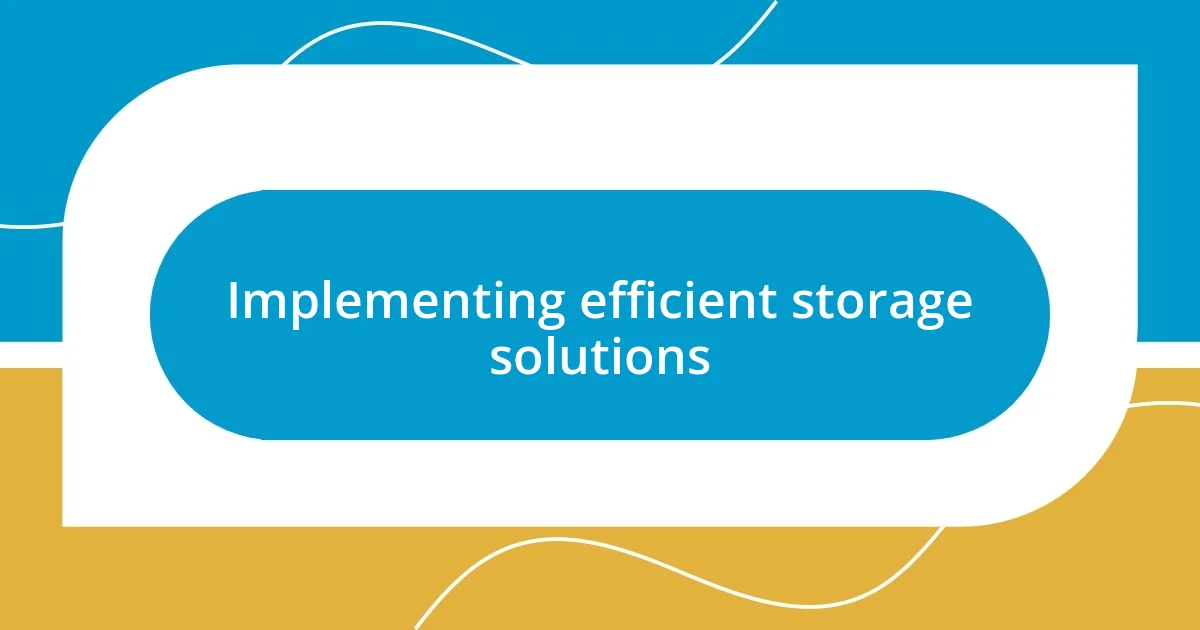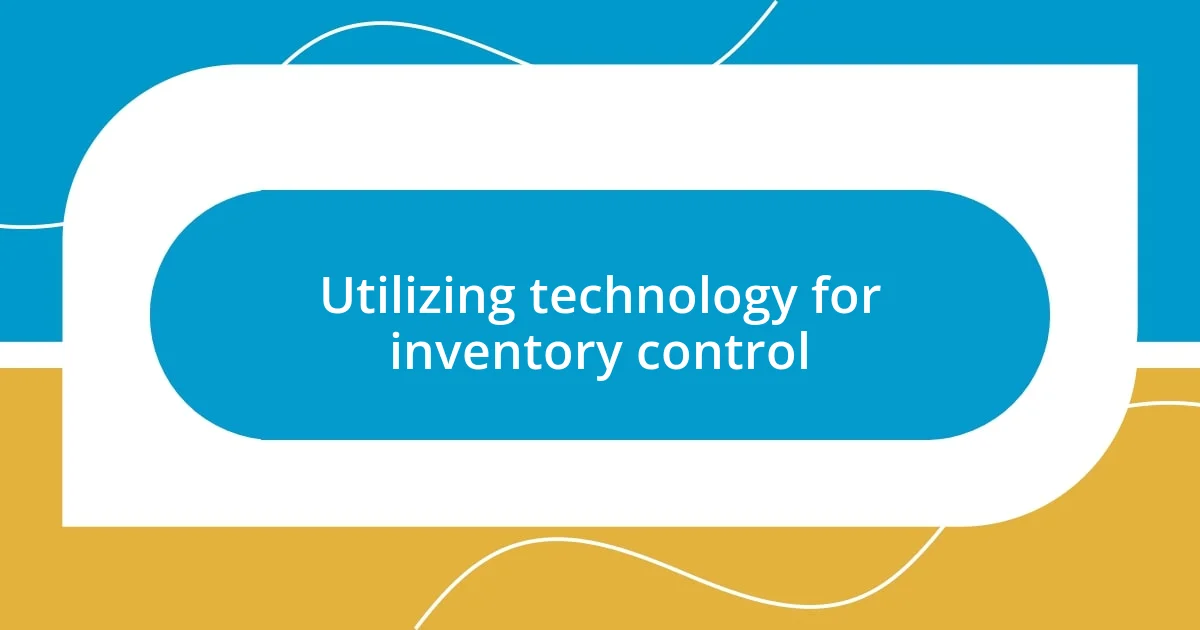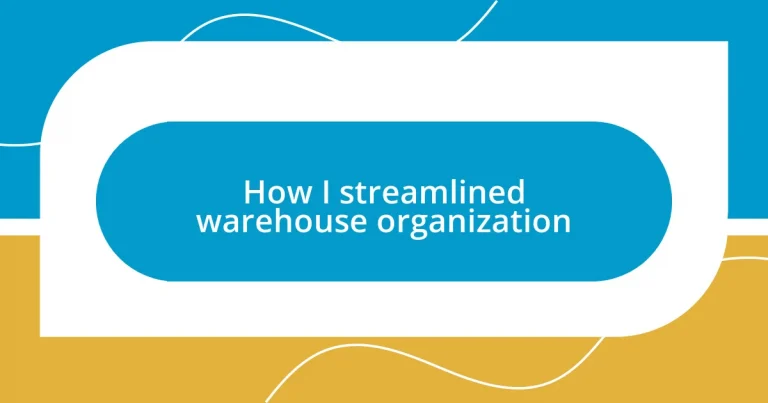Key takeaways:
- Assessing warehouse layout for efficiency revealed opportunities, such as relocating frequently picked items closer to packing areas to enhance productivity.
- Implementing strategic storage solutions, like utilizing vertical space and clear labeling, significantly improved organization and team morale.
- Regular evaluation of performance metrics and open feedback from staff were crucial in adapting to ongoing changes and optimizing warehouse operations.

Assessing current warehouse layout
Assessing the current warehouse layout is not just about checking boxes; it’s about understanding how each section flows into the next. I vividly recall the first time I walked through my warehouse with a fresh perspective. It struck me that the aisles were cluttered, and it felt more like a maze than a functional space. Have you ever felt the frustration of searching for a product, only to find it buried beneath a pile of unrelated items?
One practical step I took was mapping out the layout and analyzing each zone’s productivity. I noticed that some areas were visited more frequently than others and that traffic patterns heavily affected efficiency. This realization helped me rethink the flow of goods—could your current setup be hindering your team’s performance?
Delving into the strengths and weaknesses of the layout allowed me to recognize opportunities for improvement. For instance, I discovered that placing frequently picked items closer to the packing area significantly reduced the time it took to fulfill orders. Have you explored where your bottlenecks might be? Sometimes, the simplest changes can lead to profound improvements in overall operations.

Identifying common organization challenges
Identifying common organization challenges in a warehouse often begins with recognizing the signs of inefficiency. I remember a particularly chaotic day when my team was scrambling to locate essential inventory during a peak order period. The frustration was palpable, and it highlighted just how critical it is to pinpoint where things go awry. Disorganization leads to lost time and increased stress, which can create a ripple effect on overall productivity.
Here are some challenges I often encounter:
- Inconsistent labeling: Without clear and consistent labels, finding items can become a guessing game.
- Overcrowded aisles: When everything has its place but those places are cluttered, it can feel like you’re navigating through a labyrinth.
- Ineffective shelving: Poor shelving choices can limit accessibility and lead to time wasted searching for items.
- Underutilized space: Failing to use vertical space or create efficient zones can leave valuable square footage wasted.
- Lack of inventory visibility: Not having a clear, real-time view of stock levels makes managing replenishments problematic.
Recognizing these challenges was a turning point for me. I realized that by addressing them head-on, I could transform the chaotic, cluttered space into a well-organized, efficient haven, which drastically improved our workflow and morale. There’s something undeniably uplifting about walking through an orderly warehouse, where everyone knows where things belong.

Implementing efficient storage solutions
Implementing strategic storage solutions can truly revolutionize how a warehouse operates. In my experience, utilizing vertical space was a game changer. For example, I once transformed a standard shelving unit to extend upward rather than outward. This move not only created more room for additional inventory but also made it easier to locate items quickly. Have you ever considered how maximizing vertical space might optimize your own operations?
One effective strategy I adopted was categorizing items based on size and frequency of access. Grouping smaller, frequently picked items within easy reach not only sped up order fulfillment but also boosted team morale. I fondly remember the day after I made these adjustments; the energy in the warehouse shifted dramatically. It was as if everyone was racing with renewed focus and enthusiasm. Can you visualize how small changes in storage solutions could ignite a similar transformation in your workspace?
Finally, I can’t stress enough the importance of using clear labeling and signage. When I implemented consistent color coding for different product categories, the difference was astounding. It minimized the time my team spent navigating the aisles. I vividly recall a moment of relief when a new hire accurately located items on their first attempt. That’s the power of clarity! Have you thought about how effective labeling might impact your warehouse’s efficiency?
| Storage Solution | Description |
|---|---|
| Vertical Space Utilization | Maximizes storage by using shelves that extend upward, reducing clutter on the floor. |
| Categorization by Size | Organizes items based on frequency of access, facilitating quicker retrieval and improving workflow. |
| Clear Labeling | Employs consistent color coding and signage to streamline navigation and reduce search time. |

Utilizing technology for inventory control
Utilizing technology for inventory control can dramatically enhance efficiency in a warehouse setting. A few years back, I implemented an inventory management software that provided real-time tracking of stock levels. This change was nothing short of revolutionary. I remember the relief that washed over my team when they could check inventory from their mobile devices, eliminating the guesswork that often led to stock discrepancies. Have you ever found yourself doubting whether you have enough items on hand? That anxiety became a thing of the past for us.
Integrating barcode scanning technology was another pivotal step. It simplified the process of checking in and out inventory. Just a quick scan replaced the tedious manual entry that used to slow us down. I still recall an employee’s excited smile when they realized how much time they saved during a busy day. That boost in morale was an unexpected benefit, fostering a culture of productivity and teamwork. Can you imagine how much smoother your own operations could run with such an easy tracking system?
Additionally, utilizing cloud-based inventory systems provided us with detailed analytics that informed our purchasing decisions. Having access to data on sales trends allowed me to forecast needs accurately. I remember sharing the insights with my team during a meeting; you could sense the excitement in the room as we discussed how to position ourselves ahead of demand. Can you picture your own team strategizing based on data trends instead of merely reacting to stockouts? Such proactive planning transforms how warehouses operate, making inventory control a more manageable—and even enjoyable—process.

Training staff on best practices
Training staff effectively on best practices is essential for any warehouse to operate smoothly. I’ve always believed that investing time in training pays off significantly in the long run. One memorable training session I conducted revolved around a fun, hands-on challenge where team members had to locate items blindfolded using only the newly labeled aisles as a guide. The laughter and camaraderie that emerged from this exercise not only improved their navigation skills but also fostered a sense of team spirit. Have you considered how interactive training could engage your staff?
Another crucial aspect of training is reinforcing the importance of safety protocols. It’s a real priority in any warehouse environment, and I once had a close call when an employee nearly slipped while rushing to complete an order. This incident prompted me to create a safety workshop that focused on best practices, emphasizing awareness and caution. I remember feeling an overwhelming sense of responsibility, knowing that preventing injury was my duty. How do you emphasize safety training in your workforce?
Beyond formal training sessions, I’ve found that continuous mentorship can solidify best practices. Pairing experienced staff with newcomers creates an ongoing learning environment. I recall mentoring a new hire and witnessing her confidence grow as she became more efficient. It was rewarding to see her evolve from uncertainty to becoming a reliable team member. Could mentorship programs like this be the missing piece in your training strategy? Each of these elements nurtures a culture of excellence and care within the warehouse, and I can’t stress their importance enough.

Evaluating ongoing organization effectiveness
To truly evaluate the ongoing effectiveness of warehouse organization, I suggest implementing regular performance metrics. In my experience, we conducted monthly reviews where we analyzed key indicators like order fulfillment rates and stock turnover. The tangible evidence of improvement brought a sense of accomplishment to the team, while any setbacks sparked invigorating discussions on how we could do better. Have you ever felt that rush when you see real progress unfolding right before your eyes?
Feedback from team members is another cornerstones of assessing effectiveness. I established an open-door policy where team members could discuss challenges they faced within the workflow. I remember one employee sharing a simple yet impactful change: rearranging frequently picked items within closer reach. That adjustment not only boosted efficiency but also reinforced the idea that every voice matters in the quest for improvement. How often do you seek input from your team to fine-tune your operational strategies?
Lastly, reviewing technology’s impact on organization plays a crucial role in ongoing evaluation. After integrating new software into our processes, I always scheduled sessions to assess its performance. There were times when I was surprised by how some features went underutilized, prompting me to encourage more training. That collaborative evaluation made us more adaptable. Isn’t it fascinating how technology can streamline operations while also requiring our active participation to unlock its full potential?

Adapting to changing warehouse needs
Adapting to evolving warehouse needs requires an agile mindset. I recently faced a shift when our customer demand surged unexpectedly, turning our typical workflow upside down. It was a learning moment for me: by gathering my team and brainstorming changes, we quickly reorganized our picking routes and optimized inventory placement, allowing us to meet the heightened demand without sacrificing accuracy. Have you encountered a similar situation where flexibility made all the difference?
Over time, I realized the importance of being proactive rather than just reactive. For instance, when we noticed seasonal patterns emerging, I began implementing tailored strategies well in advance. It felt empowering to anticipate needs, rather than scrambling at the last minute. I can still remember the relief on my team’s faces when we smoothly transitioned into our summer sales period, having already mapped out our layout changes. How do you stay ahead of fluctuations in your warehouse operations?
Regularly reassessing technological tools is also vital. When we transitioned to a more sophisticated inventory management system, I took it upon myself to solicit feedback. After a few weeks, I organized a roundtable discussion, and the insights from my team were enlightening. It became evident that some features were underutilized simply because my team wasn’t aware of their full potential. I learned that fostering open communication about our tools is essential for maximizing efficiency. Do you have a strategy in place for reinforcing technological adoption in your warehouse?














